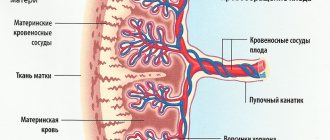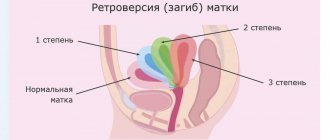The position of the fetus is determined by the location of its longitudinal axis to the length of the uterus. When they are placed along the same line, this position is physiological. The baby is placed along the uterus, and one of its round parts (the head or pelvic end) is placed towards the cervix.
What is the transverse position of the fetus? This diagnosis indicates that the baby is located across the uterus. Its axis is located at a right angle to the axis of the uterus. In this case, the position is not determined. The baby's head and pelvis are located above the crests of the pelvic bones.
Causes.
This anomaly can be caused by various factors that contribute to excessive or, conversely, insufficient activity of the baby in the womb. The main reasons for the anomaly:
- hypotonia of the abdominal muscles;
- oligohydramnios and polyhydramnios;
- fetal hypotrophy;
- tumors of the uterus and pelvic bones;
- increased myometrial tone;
- risk of spontaneous abortion;
- large fruit;
- clinically narrow pelvis;
- multiple births;
- abnormal attachment of the placenta;
- fetal development abnormalities;
- structural defects of the uterus (bicornuate, saddle-shaped).
Why me? Possible causes of presentation
This question worries every mother whose baby is settled in her stomach “not as it should be.” There are several possible reasons.
- Pathological hypertonicity of the lower segment of the uterus and decreased tone of its upper sections. The fetal head is pushed away from the entrance to the pelvis and takes a position in the upper part of the uterus. This happens after inflammatory processes, repeated curettage, multiple pregnancies, complicated childbirth, and a scar on the uterus after a cesarean section.
- Features of fetal behavior and development, for example, increased mobility due to polyhydramnios, small head size, prematurity.
- Structural features and anomalies of the uterus and pelvis: bicornuate, saddle-shaped uterus, the presence of septa or fibroids in the uterus, anatomical narrowing or abnormal shape of the pelvis.
- Limitation of fetal mobility: entanglement in the umbilical cord, oligohydramnios, etc.
Usually the position of the baby in the uterus is fixed by the 32nd–34th week of pregnancy. All these reasons only increase the risk that by this time the child will remain in the wrong position, but they cannot be considered a “final verdict.”
Symptoms.
If the fetus is not positioned correctly and there are no other pathologies, pregnancy in most cases proceeds favorably. There are no pathological symptoms. External signs may indicate an abnormal position of the fetus:
- spherical shape of the uterus;
- transversely stretched abdomen;
- the height of the uterine fundus increases slowly and does not correspond to the gestation period;
- abdominal circumference is higher than normal;
- the baby's heartbeat can be heard at the level of the mother's navel;
- The baby's pelvis and head are located on the sides of the abdomen.
Diagnostics
Detection of PPPL deviations occurs mainly during an obstetric examination of the patient.
Even visual inspection and palpation often allow an experienced specialist to suspect this disease. This is facilitated by the transverse oval stretched configuration of the abdomen, an increase in its circumference relative to gestation, and the low height of the uterine fundus. Palpation reveals the head and pelvic part of the fetus in the lateral uterine sections. In this position, during auscultation, it is possible to listen to the PL heartbeat in the umbilical region of the mother’s body.
The final diagnosis in most cases is made based on the results of ultrasound examination (ultrasound). It is informative enough to determine violations of the PL location, identify the threat of termination of pregnancy and conduct dynamic observations.
Why is the transverse position of the fetus dangerous for the mother and fetus?
Diagnosing an abnormal position of the fetus in the early stages of pregnancy should not be a cause for panic, since there is a high probability of its change to longitudinal. If this does not happen, the main danger is that when the baby is positioned transversely in the uterus, most pregnancies end in premature birth. Therefore, women with this diagnosis are carefully monitored and hospitalized in advance.
In the absence of timely medical care, the transverse position of the fetus can lead to the following complications:
- premature rupture of amniotic fluid;
- massive bleeding;
- neglected transverse position - loss of small parts, driving of the shoulder into the small pelvis, limited movements of the child;
- uterine rupture;
- infection with subsequent development of chorioamnionitis, sepsis, diffuse peritonitis;
- hypoxia or asphyxia of the fetus;
- birth of a twin fetus - occurs when the uterus is hypertonic and intense contractions, when the fetus is bent in the chest area, the birth of a live baby in this case is unlikely.
Causes of pathological presentation
- Myoma
Large nodes can deform the uterine cavity. If the fibroid is submucosal and grows primarily into the abdominal cavity, it poses less of a risk than a submucosal or interstitial nodule. The last two can significantly change the size of the uterine cavity.
It is also worth remembering that women with small tumors that were stable before pregnancy may experience accelerated growth after conception. This is due to an increase in progesterone and more progesterone receptors in the fibroid nodes. A child, trying to lie down in a comfortable position, will touch a protruding dense knot and will not be able to roll over with his head down.
- High parity of births
The reasons for the transverse position of the fetus may be multiple births. The disease is much less common in first-time mothers, but increases with 4-5 births. The increased risk is explained by a decrease in the tone of the abdominal muscles, more flabby tissues that are capable of significant stretching.
- Congenital malformations of the uterus
In the case of a saddle or bicornuate uterus, as well as in the presence of septa in its cavity, the risk of incorrect positioning is much greater. This anatomical feature is formed in utero, and it is impossible to change the shape of the uterus.
- Fetal malformations
Severe anomalies that result in altered anatomy, reduced size, or the absence of certain parts of the fetus may result in transverse orientation. This is typical for anencephaly (absence of the brain), hydrocephalus (hydrocephalus).
- Bearing placement
The location of the placenta on the posterior wall above 4-5 cm of the inside of the pharynx is correct. Fixation of the placenta below, complete presentation leads to pathological positioning of the child. In this case, natural childbirth is impossible: after opening the uterus, placental abruption occurs, massive bleeding and the death of the baby.
- Anatomically narrow pelvis
With grade 1-2 stenosis and normal fetal size, pregnancy and childbirth proceed normally. But a higher degree of narrowing, an oblique, rough pelvis, and the presence of exostoses (growths on the bones) will not allow the child to position himself correctly. Natural childbirth in this case is physically impossible.
You can read more about this pathology in a separate article.
- Malovodina
If there is insufficient amniotic fluid, the opposite happens. The baby cannot take the correct position due to limited space in the uterine cavity.
- Lots of amniotic fluid
A large amount of amniotic fluid stretches the uterus, allowing the fetus to float freely in its cavity and change position. Obstruction is caused by infection, fetal pathology, combined with intrauterine hypoxia. At the same time, the child’s motor activity increases, the woman hears active movements, which increases the likelihood of transverse or oblique localization.
- Threat of premature birth
With constant or frequent stress on the uterus, the baby feels pressure on the walls of the uterus. This makes it difficult to place it in the correct position. Thus, it may happen that the correct position is not achieved in time due to the presence of a transverse or oblique presentation.
- Fetal hypotrophy
Fetoplacental insufficiency leads to chronic hypoxia. This affects the baby’s weight: growth and weight gain are delayed, sometimes for several weeks. Insufficient weight allows it to move freely in the uterine cavity and may remain in an incorrect position relative to its axis until birth.
- Big fruit
The risk increases in the presence of pelvic narrowing of 1-2 degrees. The child does not have enough space to move, and he cannot lower himself into the pelvis, so he takes the wrong position.
- Multiple pregnancy
In the case of twins, one or both babies may be in the position that is most comfortable for them, but this may make it difficult for them to give birth naturally. It happens that the first child is positioned correctly, and the second lies across, forming a kind of belt around itself. Natural childbirth in this case is impossible; this will lead to neglect of the transverse position and death of the fetus.
Sometimes a transverse position is observed during premature birth, which occurs at 28-29 weeks and up to 37 weeks. Tumors of the adnexa above the pelvic inlet are also a risk factor.
Gymnastics with the transverse position of the fetus.
Until 34 weeks of gestation, the position of the fetus is unstable, so there is a high probability that the baby will be placed longitudinally. For this purpose, expectant mothers are prescribed corrective gymnastics during the period 30-31 weeks. This is a group of exercises that help correct the incorrect position of the fetus.
Most often recommended:
- lie on the floor, bend your legs and rest your heels on the floor, raise your pelvis above head level;
- “cat” - get on all fours, while inhaling, raise your tailbone and head, and bend your lower back, while exhaling - the opposite movements;
- take a knee-elbow position, the pelvis is placed above the head - hold for up to 20 minutes.
These exercises are performed for 1-1.5 weeks three times a day. During this period, the fetus must acquire the correct position. If this happens, the stomach must be secured with a bandage.
Correct position while sleeping is also important. The baby is more accustomed to being head down, so the mother should sleep on the side on which the baby's head is located.
Corrective gymnastics is contraindicated in the following cases:
- abnormal placement of the placenta;
- multiple births;
- umbilical cord abnormalities;
- scar on the uterus;
- presence of bloody discharge from the vagina;
- abnormalities of amniotic fluid;
- severe chronic diseases of women;
- increased uterine tone;
- uterine fibroids.
Malposition of the fetus: truth and myths
...improper position of the fetus is a 100% indication for delivery through cesarean section
No! A caesarean section is recommended in 60–70% of cases of abnormal position of the fetus in the uterus. But most often, the indication for it is not only a non-standard location, but also a number of related reasons. Natural childbirth with breech presentation is classified as pathological: its course and outcome are significantly complicated, which forces the issue to be decided in favor of a cesarean section. And in case of transverse or oblique position, facial presentation, surgical intervention is absolutely necessary.
... natural birth with breech presentation is most dangerous for boys.
Yes! When a boy is born from this position, there is a risk of injury to the scrotum, especially if the buttocks and legs are raised high. This can lead to infertility and other problems in the future. Another danger is direct thermal and painful irritation of the baby’s scrotum during a vaginal examination of the mother, moving through the birth canal, which provokes premature breathing of the baby. Therefore, a caesarean section is indicated.
...if you put headphones “with music” on your stomach, the baby will become interested and roll over.
No! In most cases, if the baby turns over, it means that he has matured enough to prepare for childbirth and was able to physically perform this “trick”. And the music has nothing to do with it. If the baby is “unwilling” or unable to roll over, these methods will especially not work.
...breech presentation negatively affects the joints.
Yes! Possible underdevelopment of joints and congenital dislocation.
...pregnancy with breech presentation is more often accompanied by complications than with cephalic presentation.
Yes! About 3 times. Complications are often accompanied by hypoxia and delayed fetal development, an abnormal amount of amniotic fluid, and entanglement of the umbilical cord.
Childbirth with a transverse position of the fetus.
If the position of the fetus does not change, then natural childbirth is not recommended and most often a planned caesarean section is prescribed.
Natural childbirth is possible with a low baby weight, but even then it is necessary to monitor the dilation of the cervix. If the dilatation does not allow birth on its own, then an emergency caesarean section is prescribed.
In the case of premature birth with a transverse position of the fetus, a decision is usually made on an emergency caesarean section.
Surgical intervention in the case of a transverse position of the fetus is quite justified, because there is a significant risk of complications during natural childbirth.
The transverse position of the fetus entails many difficulties, but they can be easily avoided if you follow all the instructions of your obstetrician-gynecologist.
Tactics for managing gestational and labor periods
To prevent complications during pregnancy and childbirth, a woman needs to plan her conception. At this stage, identifying factors predisposing to the appearance of a transverse image requires their elimination. The expectant mother should be informed that in the case of uterine fibroids, even small ones, there is a possibility of accelerating its growth. Pelvic stenosis of 3-4 degrees, pathological curvatures can be a direct indication for cesarean section.
Once pregnancy begins, measures are taken to reduce the risk of premature birth. But for a long time the position of the fetus is unstable. If he was diagnosed at 25-26 weeks, this is not a reason to panic. During this time, it is necessary to establish the cause of transverse presentation and, if possible, eliminate it.
Seizures often occur as a result of infection. Antibacterial therapy is prescribed depending on the type of pathogen. If the fetus is hypotrophic, treatment is recommended to improve blood flow and support placental function. Most causes of lateral presentation cannot be corrected.
There are ways to change unstable postures that can be used later in pregnancy, but no later than 35 weeks of pregnancy.
Gymnastics
At 32 weeks of pregnancy and up to 34 weeks, a set of corrective exercises aimed at changing the position of the baby is allowed, in the absence of contraindications. These include:
- symptoms of miscarriage - under the influence of vigorous exercise, the uterus may become tense and the labor mechanism may be activated
- uterine fibroids - the location of the node may be such that it prevents the fetus from turning over correctly (pregnancy with uterine fibroids carries the risk of bleeding and the risk of placental abruption);
- spotting - may indicate abruption of a normally located placenta, so any physical activity can speed up this process;
- Uterine scar - When exercising, be aware of possible scar damage, as well as the risk of uterine rupture in the event of exercise-induced uterine hypertension.
Caution. Exercises to invert the fetus into a transverse position cannot be performed independently at home. They are carried out under the guidance of a doctor or midwife in an antenatal clinic so that in case of complications, medical assistance can be provided.
One of the schemes was proposed by I.F. Dikana. It includes the following steps:
- From a lying position, turn onto your right side.
- Maintain this position for 10 minutes.
- Turn inside out and wait 10 minutes.
- Repeat the course 2-3 times, up to 3 attempts per day.
Do the following set of exercises:
- Lie down on a flexible, flat surface; a bed is not suitable. Turn from side to side every 10 minutes 2-3 times a day.
- Raised position of the pelvis. Apply 2-3 times a day for 10-15 minutes. To do this, place pillows under the pelvis and hips so that the legs are 20-30 cm above the head.
- The knee position should be taken 3 times a day for 15 minutes.
Some doctors recommend II Grishchenko and A. Shuleshov. It includes a set of exercises:
- Lie on your side, corresponding to the position of the fetal head, bend your legs at the hip and knee joints. Stay in this position for 5 minutes.
- Take a deep breath and roll over to the same side and stay in this position for 5 minutes.
- Extend the stem corresponding to the position of the fetus. If the head is on the right - on the right, if on the left - on the left.
- Wrap your arms around the still bent leg and move it to the opposite side of the fetal position. We make a circle with the torso slightly tilted forward. Exhale and straighten your leg.
Perform the exercise on an empty stomach so that it does not interfere with work or cause heartburn or belching.
In what position can the fetus be placed in a transverse position?
It depends on which side the head is looking from. If it is right-sided, you need to sleep on the same side. If it is turned to the left side, the mother's sleeping position should also be on the left side.
If the result of the gymnastics is positive, it is necessary to establish a new position of the fetus. Special fabric rollers have been prepared for this purpose. They are placed on the sides of the fetus and attached to the bandage. Thanks to the new device, a pregnant woman can walk before labor begins.
If the exercise does not work, your doctor will record this in your pregnancy and birth history and decide whether external rotation is needed.
Turning technique
The manipulation is carried out by a doctor only through the abdominal wall; there is no need to insert your hands into the vagina. To carry out the procedure, the following conditions must be met:
- good fetal mobility;
- correct dimensions of the pelvis (external symphysis 8 cm);
- there are no indications for premature termination of labor (CTG fetal asphyxia, placenta previa, bleeding).
In women after multiple births with a well-tight abdominal wall, external rotation is performed without anesthesia. In other cases, the woman in labor is given a Promedol solution for 30 minutes. The patient is placed on a hard couch, pulling her legs towards her. The doctor palpates the fetal head and the end of the pelvis. He places his hands so that they are on these parts and grabs them.
Then start pressing on your head, moving it towards the entrance to the pelvis. The other hand presses on the pelvic end of the fetus and moves it upward. Manipulation requires a certain strength and persistence, but at the same time caution. If the uterus has already begun to contract, rotation is performed during the rest period. When a contraction occurs, it must be avoided, but the hands do not let go of the fetus, thereby fixing its position and preventing it from returning back.
External rotation of the fetus
After the manipulation, the pregnant woman is prescribed a bandage with special rollers. External rotation does not eliminate the cause of the malposition. Therefore, recently it has been used less and less due to the high risk of complications of the procedure. These may include:
- premature rupture of amniotic fluid;
- the onset of labor;
- placental abruption;
- bleeding.
Delivery
The only real way to terminate a pregnancy with a transverse fetus is a caesarean section. The operation is carried out according to plan. To reduce the risk of complications, a pregnant woman is hospitalized at 36-37 weeks for observation and preparation for surgery.
Your doctor may try to change your baby's position before surgery. To do this, the woman lies on her side and waits for the condom to slide into place. If this is not possible in a hospital setting, a planned caesarean section is performed.
If the transverse position is neglected, regardless of the condition of the child, the birth ends only with a cesarean section and there is no expectation of spontaneous conversion.
Position correction
If before the 34th week the conclusion was made “transverse presentation of the fetus,” you should not sound the alarm and worry, because before the end of this period everything can still change and the baby may turn into a position convenient for childbirth.
A woman is recommended to perform special gymnastics, which in 75-95% of cases helps the baby to take a presentation favorable for childbirth. However, contraindications that act as an obstacle to performing exercise therapy should also be taken into account. This is the presence of a tumor-like neoplasm in the uterus, severe gestosis, etc. If it is possible to achieve the physiological location of the fetus, it is recommended to start wearing a bandage for fastening.
Exercises useful for transverse fetal position:
- before eating, lie on a hard surface on the right and left sides for 10 minutes (starting from 31 weeks of pregnancy);
- lie on your back with a cushion of clothing under your feet so that your limbs are 20-30 cm above your head, while your pelvis should be slightly elevated (15 minutes three times a day);
- sleep on the side where the fetal head is located;
- three times a day, take a pose, kneeling, leaning on your elbows for 15 minutes;
- Swimming will be useful.
Only an obstetrician-gynecologist can determine whether it is possible to have sex with the fetus in a transverse position. In most cases, if there are no other warning signs, a ban on sexual relations is not imposed.
Correct location of the fetus and types of abnormalities
Normally, during childbirth, the baby is positioned head down, facing the spine. This is the optimal position in which birth injuries are least likely.
The baby does not immediately take the correct position - while there is enough space in the uterus, he actively turns over and somersaults. But the closer to childbirth, the less room for “maneuvers” remains. As a rule, by 32–34 weeks the fetus is in the correct position. But if the baby has not taken the correct position within this period, do not panic. The fetus can turn over at 35 weeks, and even directly on the day of birth.
The most common abnormal positions of the fetus are pelvic and transverse. Diagonal happens less often.
The transverse position of the child is a situation when the fetus lies across the abdominal wall, facing the stomach or the mother’s spine. Moreover, its longitudinal axis is at an angle of 90° to the axis of the uterus.
Transverse position during childbirth occurs in 1–2% of pregnancies, but cases of transverse placement of the baby up to 32 weeks and subsequently changing the position to the correct pelvic position are more than 30%.
Breech presentation of the fetus
Breech presentation is a common cause of concern during pregnancy. However, the main thing here is not to start worrying too early. For quite a long time, the baby will have enough space in the uterus for free swimming, somersaults and elegant turns.
Up to 28 weeks of pregnancy, 20–25% of fetuses lie with their butts or legs towards the exit, but only 7–16% remain in this position until 32 weeks of pregnancy. By the time they give birth, most babies turn their heads down, preparing to go out into the big world, and only 3-4% of stubborn ones continue to “sit on their butts straight”1.
Causes of breech presentation
In most cases, breech presentation occurs for no apparent reason, simply as one of the options for the location of the fetus in the uterus. However, in 15% of cases it is possible to find an explanation for this behavior - something prevents the child from taking a different position. This happens with multiple pregnancies, with polyhydramnios or oligohydramnios (too much or too little amniotic fluid), with abnormalities of the uterus (saddle or bicornuate) or uterine fibroids, in cases where the placenta blocks the exit from the uterus.
How to diagnose a “wrong turn”
For the last 100 years, obstetrician-gynecologists have been determining the location of the fetus in the uterus with their hands using Leopold's maneuvers. When a doctor touches a pregnant woman’s belly with his hands at a reception or in a maternity hospital, he is doing exactly that—he is clarifying the location of the fetus in the uterus. The accuracy of external obstetric examination is quite high, but not one hundred percent.
In 1991, an interesting study2 was carried out - an experienced clinician examined 138 women in the gestational age from 30 to 41 weeks, and after that all patients underwent an ultrasound scan. The expert identified three out of eight breech presentations and incorrectly diagnosed breech birth in six cases. It is very easy to make a mistake with maternal obesity, a full bladder, uterine fibroids, polyhydramnios, or the location of the placenta on the anterior wall. A vaginal examination or ultrasound helps to clarify the presenting part.
Often women themselves realize that the baby is “sitting on his butt”: when the fetal head, supporting the diaphragm, interferes with breathing or the baby actively kicks the mother in the lower abdomen.
Attempts to "change direction"
At 36–38 weeks, an attempt can be made to externally rotate the fetus. This method is not easy and has a number of limitations. This procedure is carried out under ultrasound guidance, monitoring the fetal heartbeat and only in an obstetric hospital, where it is possible to quickly stop the rotation in case of sudden problems (placental abruption or rupture of amniotic fluid) and perform a cesarean section.
It is believed that external obstetric rotation is successful in half of the cases, but there are especially tricky fruits that, after a successful rotation, return to their original position. The curious can see how external rotation is performed on the WHO website.
Methods of labor management
Assistance during breech birth has its own characteristics. The first benefit was proposed by the French physician Jacques Guillemeau in 1609. Later, many prominent doctors offered their own options for managing such births. Our country has adopted the manual proposed by Napoleon Arkadyevich Tsovyanov in 1928. The essence of the method is to maintain fetal position until the birth of the head.
The German scientist Erich Bracht in 1936 proposed a similar method of conducting labor, but in combination with pressure on the head through the fundus of the uterus. These methods are still alive, but in our country it is the “Tsovyanov manual”, and in Germany it is the “Bracht method”.
A set of exercises according to Grishchenko and Shuleshova
- Starting position lying on your side. It must be located on the side where the fetal legs are located. Pull your legs towards you and stay in this position for 5–10 minutes. Then turn over to the other side, tighten your legs in the same way and lie down for another 5-10 minutes.
- Lie on your right side, first bend and then straighten. Repeat the exercise 5-10 times. Then turn over to the other side and repeat the exercise 5-10 times.
- Starting position sitting on a hard surface. Bend your leg at the knee and pull it towards you. It is necessary to do the exercise on the side where the fetal legs are located. Bend your leg and make a semicircle with it, pulling it towards your stomach. Take a deep breath and inhale and slowly return your leg to the starting position.







